
A grocery store, grocer or grocery shop (UK), is a store primarily engaged in retailing a general range of food products, which may be fresh or packaged. In everyday U.S. usage, however, "grocery store" is a synonym for supermarket, and is not used to refer to other types of stores that sell groceries. In the UK, shops that sell food are distinguished as grocers or grocery shops, though in everyday use, people usually use either the term "supermarket" or, for a smaller type of store that sells groceries, a "corner shop" or "convenience shop".
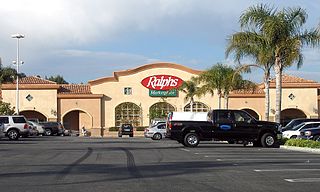
Ralphs is an American supermarket chain in Southern California. The largest subsidiary of Cincinnati-based Kroger, it is the oldest such chain west of the Mississippi River. Kroger also operates stores under the Food 4 Less and Foods Co. names in California.

Lincoln's New Salem State Historic Site is a reconstruction of the former village of New Salem in Menard County, Illinois, where Abraham Lincoln lived from 1831 to 1837. While in his twenties, the future U.S. President made his living in this village as a boatman, soldier in the Black Hawk War, general store owner, postmaster, surveyor, and rail splitter, and was first elected to the Illinois General Assembly.

Meijer Inc. is an American supercenter chain throughout the Midwest, with its corporate headquarters in Walker, Michigan, which is a part of the Grand Rapids metropolitan area. Founded in 1934 as a supermarket chain, Meijer is credited with pioneering the modern supercenter concept in 1962. About half of the company's 253 stores are located in Michigan, with the other half in Illinois, Indiana, Kentucky, Ohio, and Wisconsin. The chain was ranked No. 19 on Forbes magazine's 2015 list of "America's Largest Private Companies" and 19 in Fortune magazine's 2008 "The 35 largest U.S. private companies". Supermarket News ranks Meijer 15th on the list of Top 75 U.S. & Canadian Food Retailers & Wholesalers. Based on 2015 revenue, Meijer is the 26th-largest retailer in the United States.

Food 4 Less is the name of several grocery store chains, the largest of which is currently owned by Kroger. It is a no-frills grocery store where the customers bag their own groceries at the checkout. Kroger operates Food 4 Less stores in the Chicago metropolitan area and Southern California. Kroger operates their stores as Foods Co in northern and central California, because they do not have the rights to the Food 4 Less name in those areas. Other states, such as Nevada, formerly contained Kroger-owned Food 4 Less stores.

The Kamp Store is a historic general store building located at the northeast corner of Oak and Broadway in Kampsville, Illinois, United States. Joseph Kamp, the son of the founder of Kampsville, opened the store in 1902. The two-story wood frame building features a false front with decorative metalwork. The store provided Kampsville residents with a wide variety of goods, ranging from small household items to automobiles and heavy farming equipment. St. Louis-based suppliers shipped the store its goods via Mississippi River barges. Kamp operated the store until his death in 1952; the store served as a grocery store until the 1970s and later became a carpet store. The Center for American Archeology purchased the building in 1991 and now uses it as its Visitor's Center and Museum.

The Massie Variety Store is a historic commercial building located at 110 South Main Street in New Canton, Illinois. John Webb built the two-story brick Italianate building between 1848 and 1850 as a mercantile store. Webb sold the building to Amos Morey, who added Melville D. Massie as a partner; by 1872, Massie had become the store's only owner. The store became one of the largest in the region by the 1890s, and it had taken on other roles in the community. An opera house operated on the upper story from 1865 until the 1900s, and Massie served as an agent for local farmers who traded their products along the Chicago, Burlington and Quincy Railroad. Massie's son Harry began renting the storefront in 1918; in the following decades, it served as a drug store, ice cream parlor, grocery store, and post office before closing for good in 1948. Roger Dudley purchased the building from the Massie family in 1962 and converted it to a toy store; his business, later an antique store, operated until the 1980s.
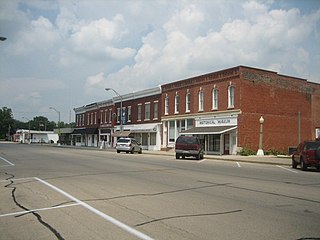
The Main Street Historic District in Tampico, Illinois, United States is a historic district notable as home to the birthplace of Ronald Reagan. The district includes the late 19th century collection of buildings that comprise Tampico's central business district, among them are two apartments that the Reagan family occupied in the early 1900s. The buildings in the district went through several periods of rebuilding during the 1870s due to major fires and a tornado. The district boundaries encompass the 100 block of Main Street and exclude properties that do not date from the historic period.
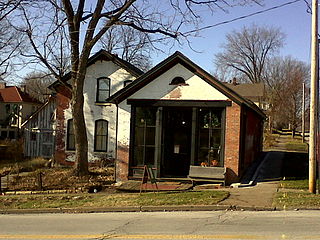
The Christian Jipp Home & Grocery is a historic building located in the Hamburg Historic District in Davenport, Iowa, United States. The district was added to the National Register of Historic Places in 1983. The house and grocery was individually listed on the Davenport Register of Historic Properties in 2005.
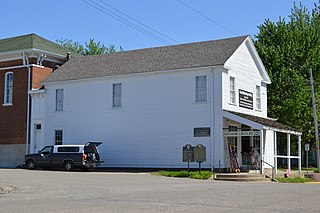
The Col. Matthew Rogers Building, also known as the Abraham Lincoln Long Nine Museum, is a historic building located at 200 S. Main St. in Athens, Illinois. The building was constructed circa 1832 by Colonel Matthew Rogers, who ran a store in the building. As Rogers was also postmaster of Athens, he moved the city's post office to his store. Abraham Lincoln, who was postmaster of New Salem at the time, frequently visited the post office during the 1830s to fetch mail. Josiah Francis purchased the store on a mortgage from Rogers in 1837. In the same year, Athens held a banquet in the building to honor Lincoln and eight other Illinois legislators for moving the state capital to Springfield; the nine men were known as the "Long Nine", as they were all over 6 feet (1.8 m) tall. When Rogers sued Francis for failing to keep up with his mortgage payments in 1840, Lincoln again became involved with the store, as his firm represented Rogers in court; Rogers won the case by default. After Rogers died in 1848, the building continued to be used as a store. The building is now a museum documenting Lincoln and the Long Nine's history and connection to the building.

Ruler Foods is a discount warehouse store grocery chain in the United States, currently owned by Kroger, and headquartered in Seymour, Indiana. It is a no-frills grocery store where 80% of the offerings are Kroger Brand, the customers bag their own groceries at the checkout, and rent shopping carts for 25 cents. Kroger operates Ruler Foods stores in Illinois, Indiana, Ohio, Kentucky, Missouri, and Tennessee.
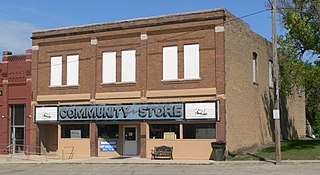
The Martilla–Pettingel and Gorder General Merchandise Store, more recently operated as the Frederick Community Store, is a store located at 312 Main St. in Frederick, South Dakota. Built in 1906, the store was originally run by Finnish immigrant August Martilla, Norwegian immigrant Paul Groder, and E. G. Pettingel. The store, which sold drugs, hardware, and general goods, closed a few years after it opened. In 1918, four Finnish immigrants opened a new store in the building, the Co-Operative Mercantile Store. Cooperative businesses were popular among Finnish immigrants, as agricultural work in Finland was frequently shared as well.
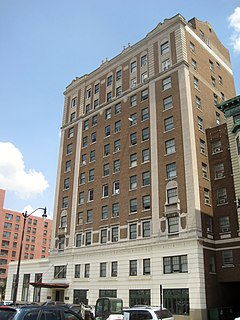
The St. Nicholas Hotel is a historic hotel building located at 400 E. Jefferson St. in Springfield, Illinois, US.

The Cattle Bank is a historic bank building located at 102 E. University Ave. in Champaign, Illinois. Built in 1858, it is the oldest documented commercial structure in Champaign. It opened as a branch of the Grand Prairie Bank of Urbana, Illinois. Champaign was the southern terminus of a railroad line to Chicago, so cattle raisers from the surrounding area drove their cattle to Champaign to ship them to the Chicago market. The Cattle Bank provided banking and loan services to these cattlemen. The building housed a bank for only three years. During that time, U.S. President Abraham Lincoln is known to have cashed a check there. From 1861 to 1971, the building housed several commercial tenants. It was added to the National Register of Historic Places in 1975 and renovated in 1983. Since 2001, the Cattle Bank has been home to the Champaign County History Museum.

East Durham Historic District is a national historic district located at Durham, Durham County, North Carolina. The district encompasses 731 contributing buildings and 1 contributing site in a predominantly residential section of Durham. The buildings primarily date between about 1890 and 1955 and include notable examples of Classical Revival and Queen Anne architecture. Notable buildings include the Holloway Street School (1928), East Durham Junior High School, Advent Christian Church (1920s), John Cheek House (1899), Community Groceries (1900), George Brown Grocery Store (1920), Seagroves Grocery Store (1915), and The People's Bank (1921).

The Virgil Hickox House is a historic house located at 518 East Capitol Avenue in Springfield, Illinois. The house, the only one remaining in downtown Springfield, was built in 1839 for Virgil Hickox and his family. Hickox was a prominent Springfield businessman who helped bring the city its first rail line, an extension of the Chicago and Alton Railroad. In addition, Hickox was a successful attorney and political figure; he chaired the Democratic State Committee for twenty years and was an associate of both Abraham Lincoln and Stephen A. Douglas. The Hickox family remodeled their house several times; when they moved out in 1880, it had largely taken its present form, with an Italianate design featuring bracketed eaves and long arched windows.
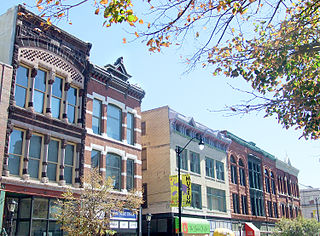
The Central Springfield Historic District is a 12-acre (4.9 ha) historic district in downtown Springfield. The district encompasses Springfield's oldest commercial district and is centered on the Old State Capitol. While the area was platted in 1822, only two buildings in the district predate the 1850s: the Old State Capitol and the Lincoln-Herndon Law Offices, both built in 1837. The majority of the district's buildings were constructed during Springfield's population boom in the 1860s and its subsequent growth in the latter half of the 19th century. These buildings included hotels, drug stores, groceries, clothing stores, and dry goods stores; some of the stores built in this period are still in operation. The businesses are also significant examples of 19th-century brick commercial architecture, including the Romanesque Pierick-Sommer Building and several works by prominent Springfield architects Helmle & Helmle.

The Saltus Grocery Store is a historic mixed-use commercial and residential building at 299-301 North Winooski Street in Burlington, Vermont. Built in 1897, it is a well-preserved example of a neighborhood store of the period. It was listed on the National Register of Historic Places in 2001.
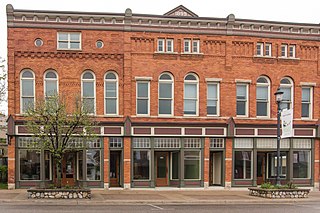
The East Jordan Lumber Company Store Building is a commercial building located at 104 Main Street in East Jordan, Michigan. It was listed in the National Register of Historic Places in 2008. It is next to, and shares a wall with, the Votruba Block; both buildings have been rehabilitated to form the Main Street Center office complex.

The Ogilvie Building is a commercial building located at 4443 Main Street in Port Hope, Michigan. It was listed on the National Register of Historic Places in 1987.






















